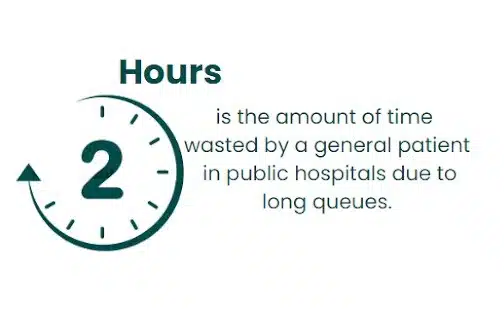
Let’s first discuss how big is the queue problem in India? It’s big. A study by the National Health Authority of India in 2020-21 revealed that outpatient waiting time in public hospitals can stretch over 2 hours.

Such conditions not only frustrate patients but also require extra efforts from medical staff, reducing their productivity. Alright, so what exactly is a queue management system?
At its core, Queue management system (QMS) is a powerful software solution designed to manage and reduce waiting times in various service areas. The system is a game-changer for the hospitals, banks and government offices that typically see large influxes of customers during working hours.
By implementing an efficient QMS, businesses can organize and optimize their customer flow, providing a seamless experience from the moment customers walk in until they leave.
In simple words, the system is like a digital conductor for your waiting room. Where customers register themselves upon arrival. Then, the system assigns a ticket number and provides an estimated wait time based on the current queue. They receive an sms-alert before their turn for service.
In India, the adoption of QMS is on the rise. With a compound annual growth rate (CAGR) of 5.5%, India stands as the third-largest revenue generator for QMS in the Asia-Pacific region.
How does a queue management system works
The working of the queue management system can be divided into several steps as given below. Basically, the system helps customers by providing them a structured process.
- Customer Arrival: A customer arrives at the service location e.g. hospitals, or banks.
- Registration: The customer gets a token or number using a ticket dispenser, kiosk, or mobile app.
- Queue Management: Each customer has a unique token number and the system assigns a queue position and displays the estimated wait time. It may also collect customer information for service prioritization.
- Service Call: When a service agent becomes available, the system alerts the next customer in line, either through a display screen, audio call, or a mobile app notification.
- Service Delivery: The customer receives service from the designated agent.
- Feedback and Data Collection: The system may offer the option for customers to provide feedback on their experience in general with the services offered at Hospital/Bank/Restaurant.
Additionally, the QMS collects data on wait times, service duration, and customer volume for future analysis. These wait times not only tells you if your customers are happy but also lets you get an estimate of your capacity of handling customers. This becomes crucial mostly in case of hospitals and banks which have multiple departments. One needs data to know about the performance of each and every department.




























